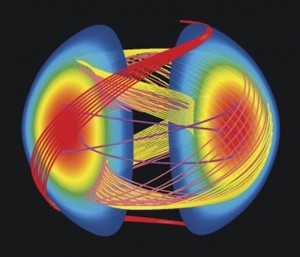
Process makes quantities of thermoelectric materials
More than two-thirds of the energy from primary sources like oil and gas is lost through waste heat, according to scientists at the Fraunhofer Institute for Physical Measurement Techniques IPM (Freiburg, Germany). Thermoelectric modules can make use of part of that waste heat, and researchers at the institute have devised a way to produce half-Heusler alloys—some of the most efficient thermoelectric materials—in kilogram quantities. The alloys consist of a range of materials, including nickel, and are said to be more nickel being one, and are said to be more environmentally friendly than previous materials, possess good thermoelectric properties, and withstand high temperatures. Prototypes of a thermoelectric system devised by the scientists have already converted the waste heat from an automotive exhaust into up to 600 W of electrical power, according to a news release.
Nanostructured black silicon fights bacteria
Researchers at Swinburne University of Technology (Australia) say they have developed a bio-inspired black silicon material that can kill bacteria at up to 450,000 cells per minute of exposure per square centimetre of available surface. The nanostructured material is etched to create long, narrow protrusions on its surface. Surfaces with similar features are common in the natural world—in particular, the scientists studied the wing surface of the Diplacodes bipunctata dragonfly, which features spike-like nano structures that kill both rod-shaped and spherical bacteria. The mechanical antibacterial effect is unrelated to surface chemical composition, and instead works by essentially impaling the bacteria on the nanostructures, the researchers say. The approach could enable development of a new generation of antibacterial nanomaterials that could be applied to medical implants and other surfaces, they add.
Microchip-size devices may replace optical waveguides
Scientists working on the US Defense Advanced Research Project Agency’s integrated Photonic Delay program have demonstrated low-signal-loss, microchip-scale integrated waveguides for photonic delay. The iPhoD program resulted in creation of a new class of photonic waveguides with losses lower than those of optical fiber devices. The new waveguides are built onto microchips; conventional fiber optic coils of the same delay length would be about the size of a small juice glass, according to DARPA. The waveguides also employ modern silicon processing techniques to achieve submicron precision and more efficient manufacturing, the agency says, resulting in a new component that is smaller and more precise than anything before in its class. Photonic delays are useful in military application ranging from small navigation sensors to wideband phased-array radar and communication antennas, the agency says.
Theoretical self-healing composites could regenerate if damaged
Researchers at the University of Pittsburgh have developed computational models for a polymer gel that would enable complex materials to regenerate themselves if damaged. Inspired by biological processes in species such as some amphibians, which can regenerate severed limbs, the team developed a hybrid material consisting of nanorods embedded in a polymer gel containing monomers and cross-linkers. When part of the gel is severed, the nanorods near the cut act as sensors and migrate to the new interface. Functionalized chains on one end of the nanorods keeps them localized at the interface, and sites along the rod’s surface trigger a polymerization reaction with the monomer and cross-linkers in the outer solution to repair the damage.
New solar design is efficient, scalable
Typically, silicon photovoltaic cell manufacturers add a grid of thin silver lines to the cell via a screen-printing process to form the front contacts. A new design developed by researchers at the US Department of Energy’s National Renewable Energy Laboratory and solar startup TetraSun instead loads 50 μm wide copper electrodes on its front contacts in a way that prevents diffusion of the metal, which can degrade performance. The developers say the process exceeds the performance of traditional heterojunction cells without special equipment, complicated module assembly, or transparent conductive oxides. The copper electrodes are much less expensive than silver, and the process should lend itself to high-volume manufacturing, they add.

